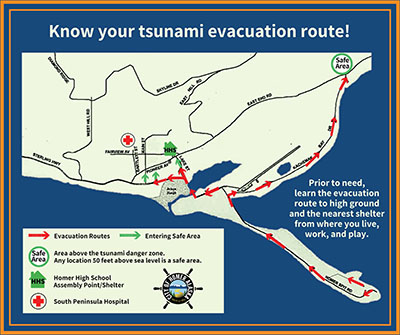-
About Homer
-
- Americans with Disabilities Act Compliance Program City Campgrounds Community Recreation Hickerson Memorial Cemetery
- Library Parks & Trails Public Safety Fire Police Emergency Information
- Events & Activities City Calendar Library Calendar Recreation Calendar Doing Business in Homer Sister City Program Coast Guard City
-
- Departments
- Government
- How Do I?
Know Homer's Evacuation Routes and Safe Zones

Many of us live, work, shop or play in Homer's tsunami danger zone. Tsunamis don't happen often, but when they do, knowing Homer's tsunami inundations zones and where to go during a tsunami evacuation ahead of time is crucial to your survival--you may only have minutes to get to safety.
Homer's Tsunami Inundation Zones
Recent maps (attached below) published by the Alaska Earthquake Center put Homer's maximum inundation height at 50 feet. If you are below 50 feet in elevation you are in the danger zone and should evacuate immediately to higher ground if you get a tsunami warning sign.
You can determine if where you live, work or play is in the danger zone in two ways:
- Find your location on the maps below or on the interactive tsunami inundation map on the Alaska Earthquake Center's website. The interactive website map includes both flow depths and inundation boundaries.
- The Homer Police Department, upon request, will pay a visit and determine your property's elevation. To set up a visit, call HPD at 235-3150.
Homer's Tsunami Evacuation Routes
A map of Homer's evacuation routes are attached below. Actual routes are marked with official blue and white Tsunami Evacuation Route road signs.
- From the Homer Spit proceed immediately inland on Homer Spit Road. Turn right (east) on Kachemak Drive. Proceed all the way east on Kachemak Drive to East End Road.
- From areas south of Beluga Slough, proceed to Kachemak Drive and evacuate east on Kachemak Drive to East End Road.
- From areas north of Beluga Slough, proceed north on Lake Street, Heath Street or other north-south connector roads toward Pioneer Avenue. Pioneer Avenue is well above the tsunami inundation zone.
Stay Safe During a Tsunami Evacuation
During a Tsunami evacuation, it's important to quickly get to and stay at high ground until authorities issue the all-clear. A tsunami is not one big wave, it is a series of inundations. People in the past have had injuries or loss of life because the first wave comes in and people go back home, and then the second, often bigger wave comes.
Click on the attachment below for a brief overview of how to stay safe when a tsunami threatens.
What If I'm In My Boat?
General recommendations from the National Tsunami Hazard Mitigation Program and the US Coast Guard is that boaters do NOT try to take vessels offshore before or during a tsunami. And, if you are offshore, you should not try to re-enter the harbor until the harbor master or port captain indicates it is safe to do so. See attachment below for full recommendations.


